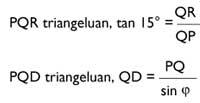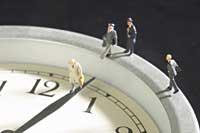Atomic precision
2003/10/19 Kortabarria Olabarria, Beñardo - Elhuyar Zientzia
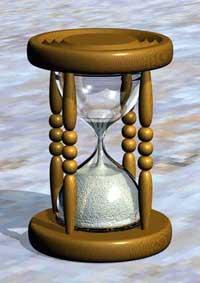
The U.S. Army Research Department has presented the atomic clock in the pocket. The clock has the size of a box of matches and is very precise, it will lose a second in the following 10,000 years.
Traditional watches are less accurate. No such precision is needed in normal life. The arrival at the signing, the appointments or the bus station, of a second before or after, usually nothing happens. On the other hand, precision is fundamental for driving ships or planes, in communications, launching a missile… This has motivated the interest of the Army.
As for accuracy, the new atomic clock, named Ultra-miniature Rubidium Atomic Clock, is not the most accurate clock in the world. If they are more accurate but not of this size. The atomic watches that can be purchased on the market are large and heavy. For example, atomic clocks of cesium have a volume of 5,000 cubic centimeters, a small backpack, and consume about 50 watts. On the contrary, the small atomic clock needs a single wat to function, with a volume of only 40 cubic centimeters.
The new watch is totally optical. The laser light that comes out of the Vertical Cavity Surface Emitting Laser (VCSEL) technology to work. This new technology has been developed to respond to the telecommunications needs that use fiber optics, industry in which very compact lasers are needed. Although the clock has been presented by the Army, the company Kernco has done so.
Watches in history
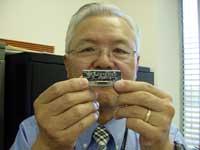
Hours, minutes, seconds… the man has had to divide the time in order to somehow organize life. Ancient civilizations distinguished between day and night, or the cycles of the Moon or the seasons of the year. Human intelligence gradually, without haste, learned to divide time, invented the clock.
First they used sundials. By means of a quadrant, on a flat surface the shade of the Sun gave time. Today, sundials can be seen in many places. This system of measuring the time used by the Chinese for a long time, according to archaeologists, 3,000 years before Christ. It was also used in ancient Egypt and in Inca civilization. Of course, sundials did not serve for the night, nor for the dark and cloudy days, nor for the hours of darkening and sunrise. In addition, the quadrants should be adjusted to the latitudes of the Earth, since the inclination of solar rays is not the same everywhere. The duration of the day is not always the same, it varies according to the seasons of the year, so the time measurement was not totally safe. But there was something.
Later, clepsidras, water clocks were invented. They were containers filled with water. They were first used in Babylon and Egypt, but they were also conquered by Greeks and Romans. The water passed from a container to a graduated container and as it was filled it marked the past hours. The Romans devised a similar system for their nocturnal use, based on marked candles.
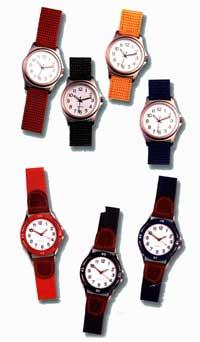
Sand watch III. It is an invention of the twentieth century. It rests on two containers and a very narrow passage. Today they are used as decorative elements, but at some time there were also sand watches capable of measuring the time of the whole day.
Five centuries passed until the appearance of the first machines to measure time. VIII. In the nineteenth century, an Italian named Pacifico built a clock with counterweights. It was acquired by Pope Paul I and subsequently given to King Pipino III, known as Small or Short. From then on, the machines of this aspect began to become conventional. By 1300 the European churches were implanted on numerous occasions. Today you can still see one of them in England, in the cathedral of Salisbury. It was placed in 1386 and is in good condition.
In 1600 Galileo Galilei discovered the Pendulum Law. This gave a great strength to counterweight based watches. 57 years after the discovery of the law, Dutch mathematician and physicist Christian Huygens made the first pendulum clock. He placed the whole mechanism on a wall.
By then there was already a century in which the first key watches in the city of Nüremberg were invented by the German Peter Henlein. Thanks to this, they began to manufacture portable watches. Geneva's fame in watchmaking comes from this era. The legislation based on Calvinism prohibited the contrincantes from constructing crosses, calyxes and religious instruments. For this reason, in collaboration with watchmakers, they began to build boxes to put watches.
With the passage of time, the advance of watchmaking was evident, but occasionally problems occurred. One of them, and not the least, was the wear and tear of the pieces, since it caused a bad measurement of time. The problem was solved when blondes and sapphire were used in the clamping axes of the mechanism. The hardness of these stones significantly reduced the number of pieces that deteriorated by erosion.
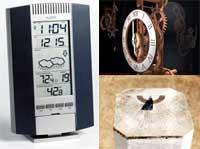
Watches of all shapes, qualities, shapes, sizes and colors can now be purchased: by hand, chronometers, alarm clocks, manuals, digital, atomic… The first watch on the wrist was drawn by the Swiss Hans Wildorsf in 1904 for Rolex. Six years later he designed the first chronometer of the wrist. On the other hand, atomic watches began in the 50s. They were one of the first peaceful applications of nuclear force. The relationship between quartz and watch, digital watches, is from the 80s. Undoubtedly, there has been a long way in time.
Published in 7K.

Gai honi buruzko eduki gehiago
Elhuyarrek garatutako teknologia





